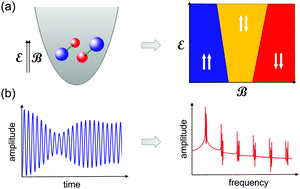Magnetic properties and quench dynamics of two interacting ultracold molecules in a trap†
Abstract
We theoretically investigate the magnetic properties and nonequilibrium dynamics of two interacting ultracold polar and paramagnetic molecules in a one-dimensional harmonic trap in external electric and magnetic fields. The molecules interact via a multichannel two-body contact potential, incorporating the short-range anisotropy of intermolecular interactions. We show that various magnetization states arise from the interplay of the molecular interactions, electronic spins, dipole moments, rotational structures, external fields, and spin–rotation coupling. The rich magnetization diagrams depend primarily on the anisotropy of the intermolecular interaction and the spin–rotation coupling. These specific molecular properties are challenging to calculate or measure. Therefore, we propose the quench dynamics experiments for extracting them from observing the time evolution of the analyzed system. Our results indicate the possibility of controlling the molecular few-body magnetization with the external electric field and pave the way towards studying the magnetization of ultracold molecules trapped in optical tweezers or optical lattices and their application in quantum simulation of molecular multichannel many-body Hamiltonians and quantum information storing.

- This article is part of the themed collections: Quantum computing and quantum information storage: Celebrating the 2022 Nobel Prize in Physics and Quantum Computing and Quantum Information Storage


 Please wait while we load your content...
Please wait while we load your content...